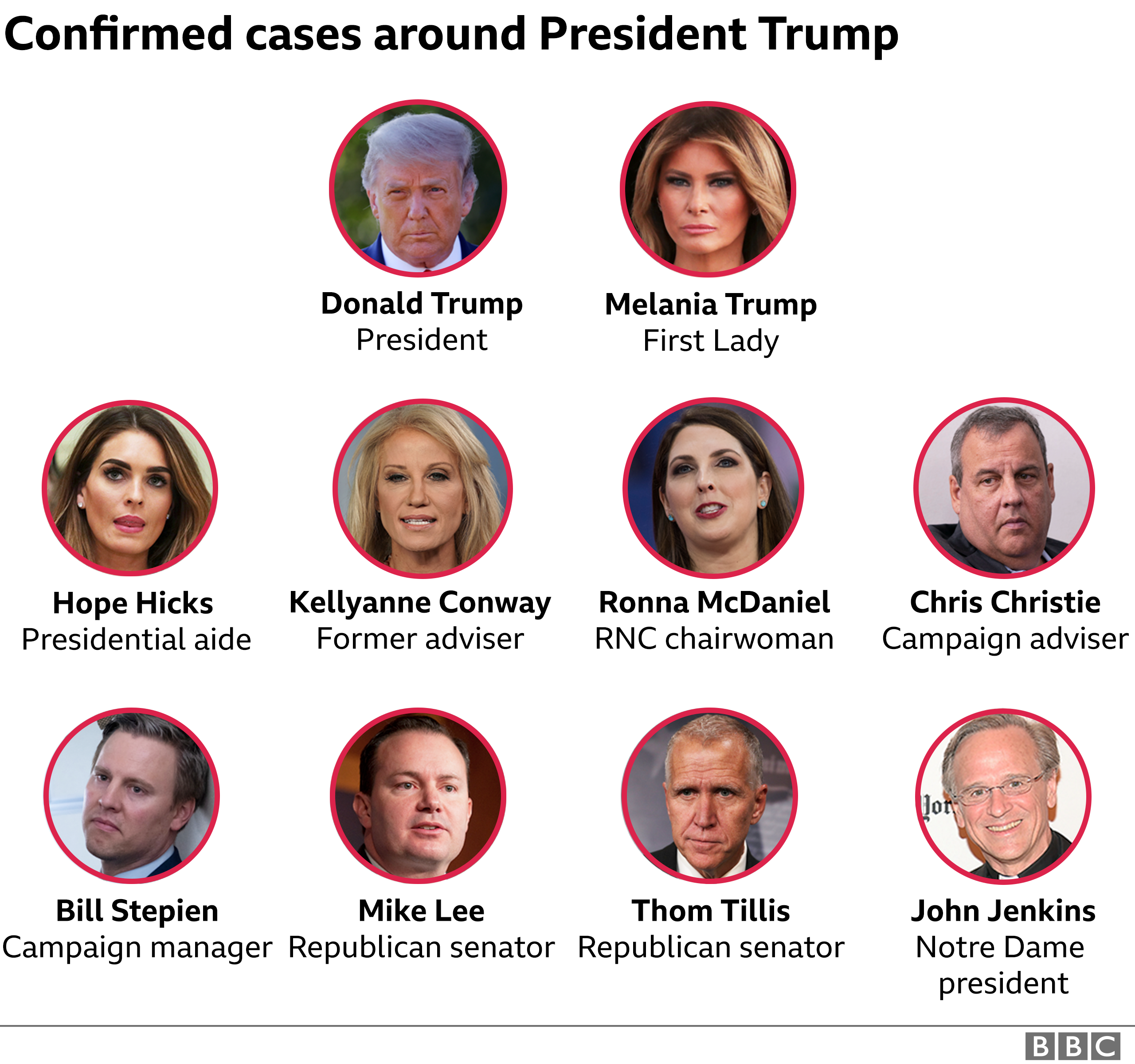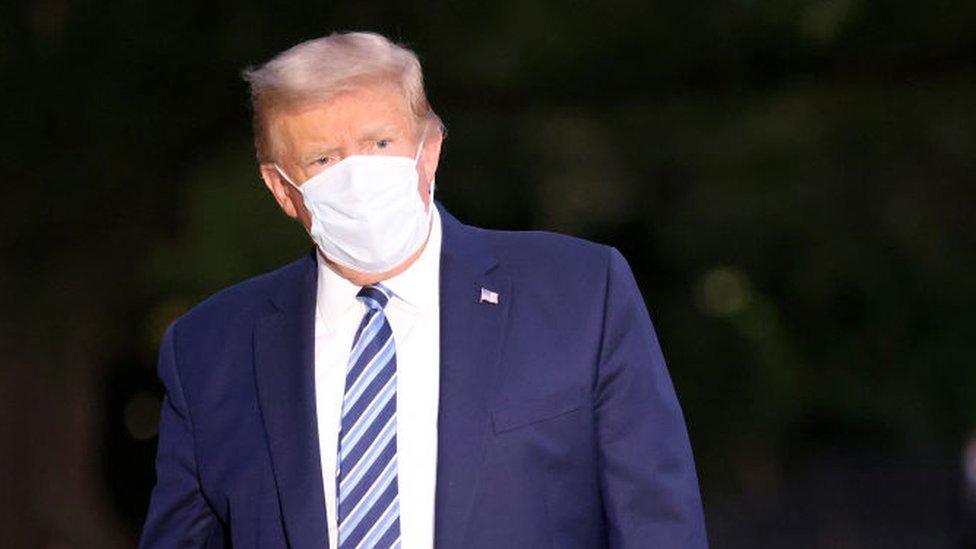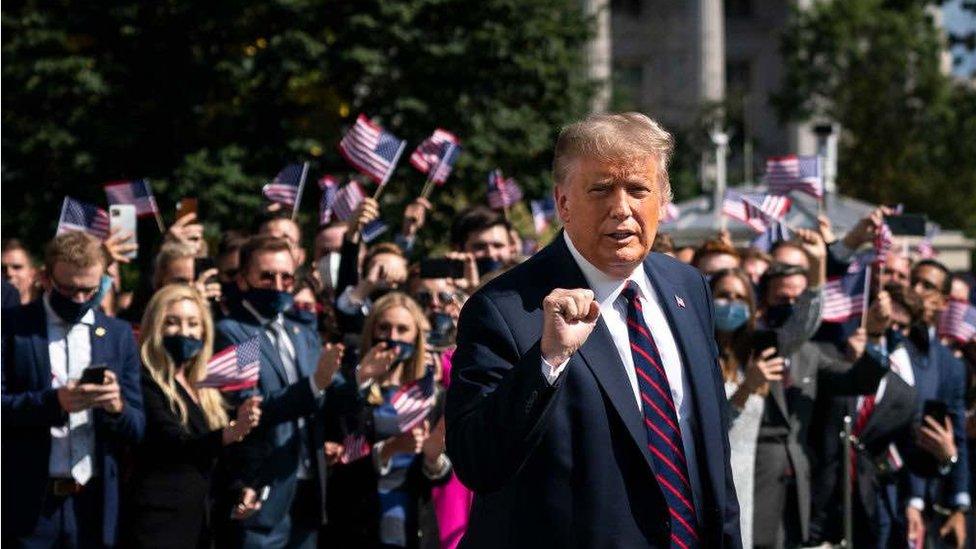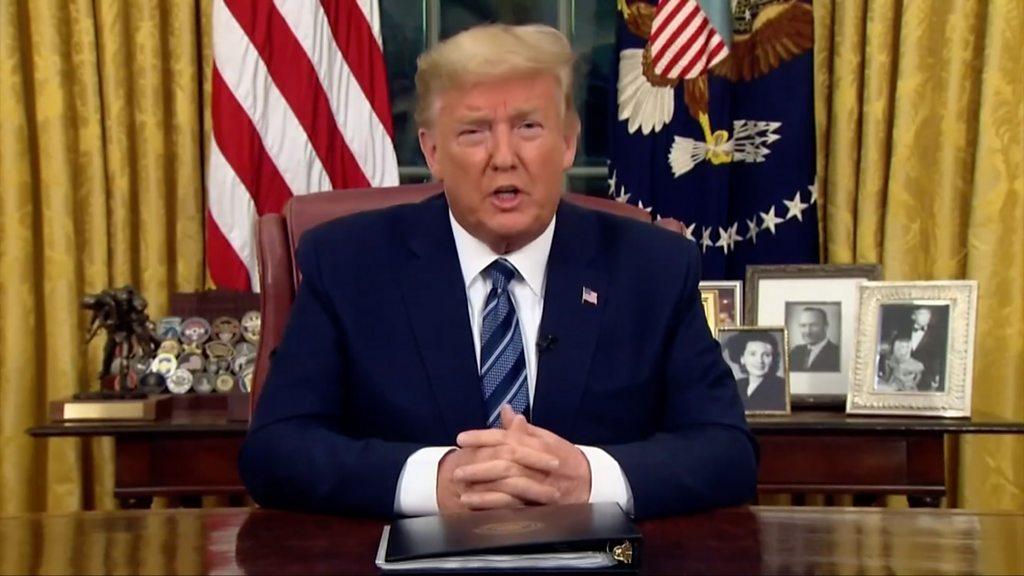Trump doctors say president is doing well, others express concern
- Published
Doctors looking after the US president said they're "cautiously optimistic, but he's doing great"
US President Donald Trump is doing "very well" in hospital after his Covid-19 diagnosis, his doctors say, but their account has been disputed.
Dr Sean Conley said the president was not being given extra oxygen for now and had been fever-free for 24 hours.
Moments later, the White House chief of staff expressed concern about the president's condition, saying he was not yet on a clear path to recovery.
Mr Trump faces Joe Biden in the 3 November presidential election.
The positive diagnosis, made public by the president in a tweet early on Friday, has upended his campaign and also cast doubt on his attempt to get a new Supreme Court judge confirmed before polling day.
The president is expected to remain at the Walter Reed National Military Medical Center close to Washington DC for a "few days", according to the White House. Dr Conley said he was "cautiously optimistic" about Mr Trump's condition but that he could not give a timetable for his discharge.
The doctors' assessment was contradicted by Mark Meadows, the White House chief of staff, who told reporters the president's vital signs over the last 24 hours had been "very concerning" and that the next 48 hours would be critical.
The president, being 74, a man and someone categorised as obese, is in a higher-risk category for Covid-19. He has so far been treated with an experimental drug cocktail injection and antiviral medication remdesivir.
Writing on Twitter later, the president said:, external "Doctors, nurses and all at the great Walter Reed Medical Center, and others from likewise incredible institutions who have joined them, are amazing... With their help, I am feeling well!"
What else did the doctors say?
Speaking at a news conference on Saturday morning, Dr Conley refused to say whether the president had ever been on oxygen despite being repeatedly questioned. "None at this moment and yesterday with the team, while we were all here, he was not on oxygen," he said.
Shortly afterwards, several US media reported that doctors had given the president supplemental oxygen at the White House on Friday before deciding to transfer him to Walter Reed. It was not clear whether he had trouble breathing and needed it.

Donald Trump was last seen in public on Friday, as he arrived at the military hospital
Dr Conley said some of the president's symptoms including a mild cough and nasal congestion were "now resolving and improving", adding: "At this time the team and I are extremely happy with the progress the president has made".
There was also some confusion after he said the team were "72 hours" into the president's positive diagnosis. If confirmed, it would suggest Mr Trump attended two large campaign events possibly knowing he was infected.
Later in a statement released by the White House, Dr Conley clarified he meant to say "day three" instead of 72 hours, and said the president had been first diagnosed with Covid-19 on Thursday evening.
First Lady Melania Trump, who has also tested positive and is isolating at the White House, was "doing great", Dr Conley said.
Sean Dooley, another doctor on the team treating the president, described Mr Trump as being in "exceptionally good spirits" having said earlier: "I feel like I could walk out of here today".

Instead of clarity, more confusion

One would imagine the purpose of the White House medical team's news conference was to reassure the public that the president is doing well and that the nation's top medical experts are on top of the situation. Instead, they created more confusion.
Sean Conley initially said Mr Trump was diagnosed "72 hours" ago - which would be Wednesday morning. That is before the president travelled to Minnesota for a campaign rally, before he flew to New Jersey for a fundraiser on Thursday and more than 36 hours before the president revealed his coronavirus diagnosis.
The timeline was further muddied by the revelation that the president was given an antiviral treatment 48 hours ago - also before his announcement. All this necessitated a quick walk-back by the White House. It is only the latest time over the course of the Trump presidency the White House communications office has had to issue clarifications or clean-ups.
Now, however, the stakes could not be higher. Dr Conley also tried to paint a positive picture of the president's current medical condition. Then, just minutes later, Mark Meadows struck a very different tone.
It is important for the White House to communicate clearly with the American people - and to the world as a whole, where allies and adversaries are closely watching the US situation. This is not just a health issue for the president, it is a security issue for the entire nation.

Who else around the president has tested positive?
Dr Conley did not respond to questions about when and where he believed Mr Trump had been infected. A crowded Rose Garden event last weekend, when the president formally announced his nomination of the conservative Amy Coney Barrett for the Supreme Court, is coming under intense focus.
Aside from the president and the first lady, six other people who attended are now confirmed to have the virus. On Saturday, campaign adviser and former New Jersey Governor Chris Christie became the latest to report a positive result.
President Trump's seven days before his Covid-positive test
Other people to have tested positive around Mr Trump include close aide Hope Hicks - believed to be the first to show symptoms - campaign manager Bill Stepien and former White House counsellor Kellyanne Conway.
Meanwhile, Republican Majority Leader Mitch McConnell said the Senate would postpone its work in full session until 19 October, but that work at the Judiciary Committee - which will examine Judge Barrett's nomination - would continue.
Later on Saturday, the senator said in a tweet he had had a phone call with the president,, external who sounded "well and says he's feeling good".
Mr Trump remains in charge. Vice-President Mike Pence, to whom under the constitution the president would transfer power temporarily should he become too ill to carry out his duties, tested negative.
The president was last seen in public on Friday evening. Before being flown to the military hospital he waved and gave a thumbs-up to reporters but said nothing before boarding his helicopter.


- Published6 October 2020

- Published5 October 2020

- Published6 October 2020
